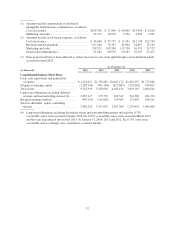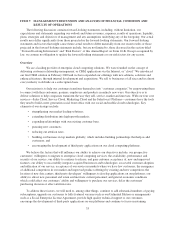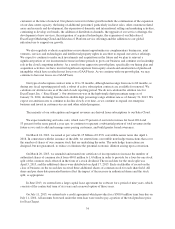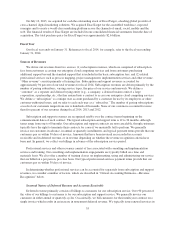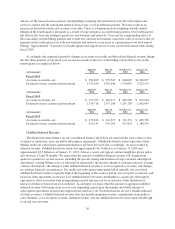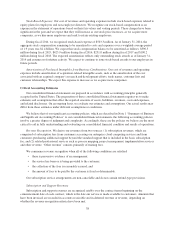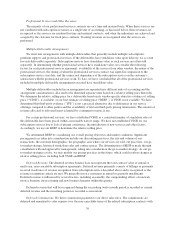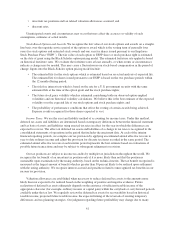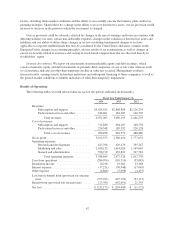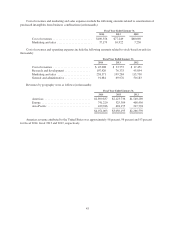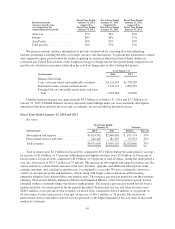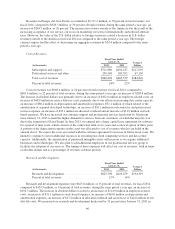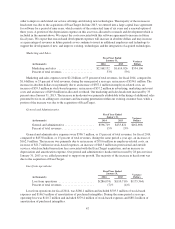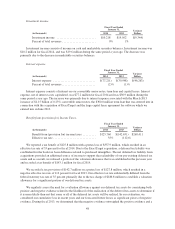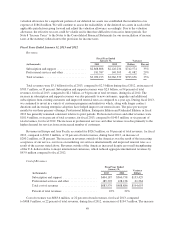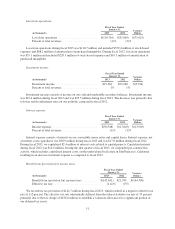Salesforce.com 2014 Annual Report Download - page 45
Download and view the complete annual report
Please find page 45 of the 2014 Salesforce.com annual report below. You can navigate through the pages in the report by either clicking on the pages listed below, or by using the keyword search tool below to find specific information within the annual report.• uncertain tax positions and tax related valuation allowances assumed; and
• discount rates.
Unanticipated events and circumstances may occur that may affect the accuracy or validity of such
assumptions, estimates or actual results.
Stock-Based Options and Awards. We recognize the fair value of our stock options and awards on a straight-
line basis over the requisite service period of the option or award which is the vesting term of generally four
years for stock options and restricted stock awards and one year for shares issued pursuant to our Employee
Stock Purchase Plan (“ESPP”). The fair value of each option or ESPP share or stock purchase right is estimated
on the date of grant using the Black-Scholes option pricing model. The estimated forfeiture rate applied is based
on historical forfeiture rates. We evaluate the forfeiture rates at least annually, or when events or circumstances
indicate a change may be needed. This may cause a fluctuation in our stock-based compensation in the period of
change. Inputs into the Black-Scholes option pricing model include:
• The estimated life for the stock options which is estimated based on an actual analysis of expected life.
The estimated life for shares issued pursuant to our ESPP is based on the two purchase periods within
the 12 month offering period;
• The risk free interest rate which is based on the rate for a U.S. government security with the same
estimated life at the time of the option grant and the stock purchase rights;
• The future stock price volatility which is estimated considering both our observed option-implied
volatilities and our historical volatility calculations. We believe this is the best estimate of the expected
volatility over the expected life of our stock options and stock purchase rights; and
• The probability of performance conditions that effect the vesting of certain awards being achieved.
Expense is only recognized for those shares expected to vest.
Income Taxes. We use the asset and liability method of accounting for income taxes. Under this method,
deferred tax assets and liabilities are determined based on temporary differences between the financial statement
and tax basis of assets and liabilities using enacted tax rates in effect for the year in which the differences are
expected to reverse. The effect on deferred tax assets and liabilities of a change in tax rates is recognized in the
consolidated statements of operations in the period that includes the enactment date. At each of the interim
financial reporting periods, we compute our tax provision by applying an estimated annual effective tax rate to
year to date ordinary income and adjust the provision for discrete tax items recorded in the same period. The
estimated annual effective tax rate at each interim period represents the best estimate based on evaluations of
possible future transactions and may be subject to subsequent refinement or revision.
Our tax positions are subject to income tax audits by multiple tax jurisdictions throughout the world. We
recognize the tax benefit of an uncertain tax position only if it is more likely than not that the position is
sustainable upon examination by the taxing authority, based on the technical merits. The tax benefit recognized is
measured as the largest amount of benefit which is greater than 50 percent likely to be realized upon settlement
with the taxing authority. We recognize interest accrued and penalties related to unrecognized tax benefits in our
income tax provision.
Valuation allowances are established when necessary to reduce deferred tax assets to the amounts more
likely than not expected to be realized based on the weighting of positive and negative evidence. Future
realization of deferred tax assets ultimately depends on the existence of sufficient taxable income of the
appropriate character (for example, ordinary income or capital gain) within the carryback or carryforward periods
available under the tax law. We regularly review the deferred tax assets for recoverability based on historical
taxable income, projected future taxable income, the expected timing of the reversals of existing temporary
differences and tax planning strategies. Our judgment regarding future profitability may change due to many
41



